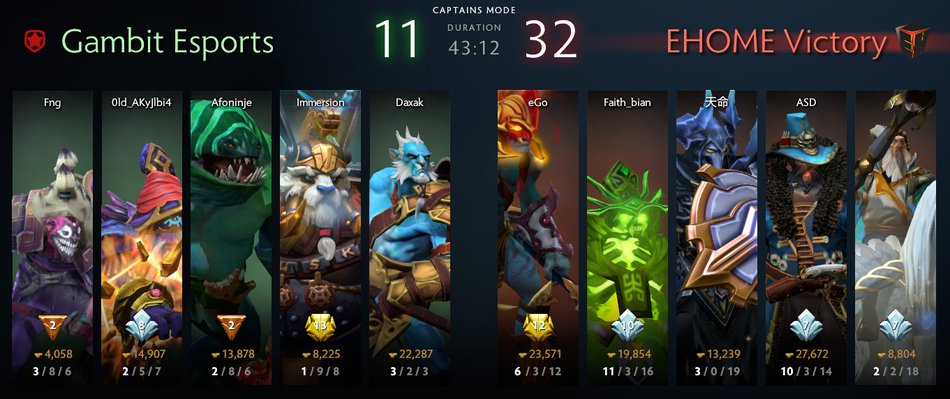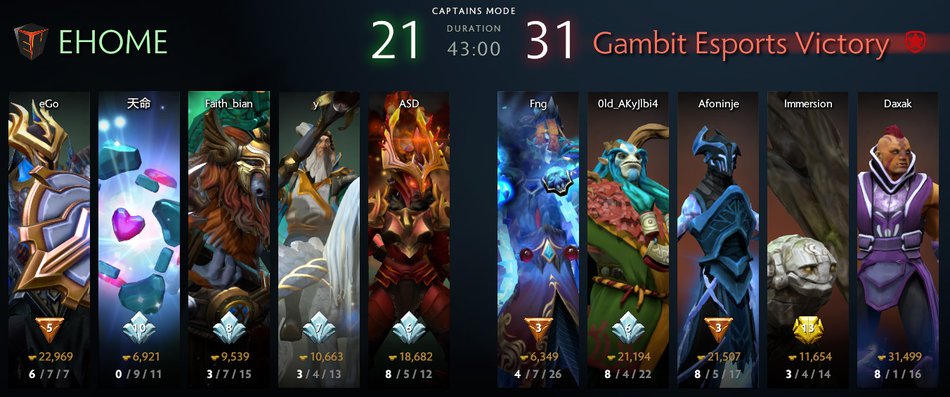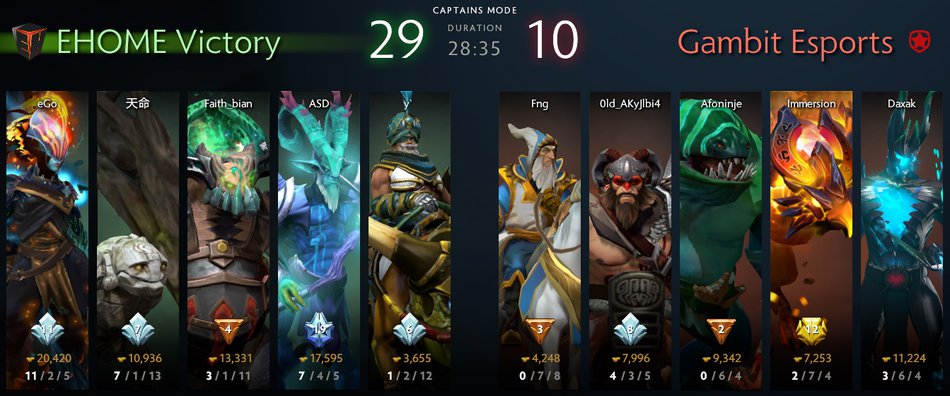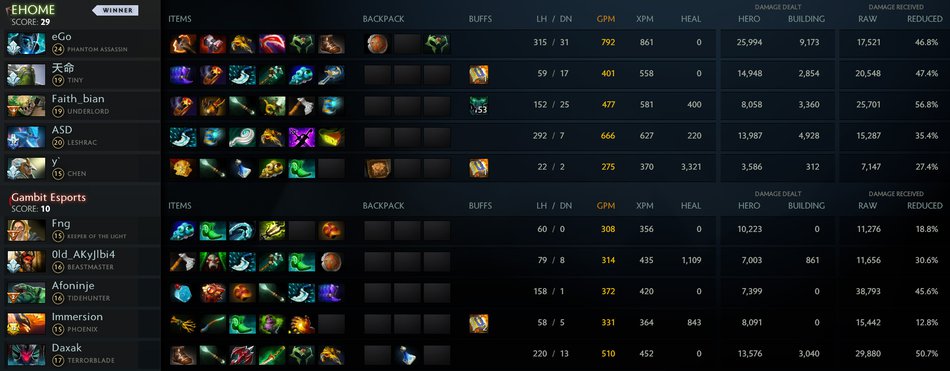- English
- Русский
The
Bucharest minor is over and Ehome claimed a convincing victory, building a lot
of hype for the major.

Photo: Ehome
The young Chinese team made a huge statement – they dropped only one game the entire tournament. In the grand finals, they picked 18 different heroes (in 4 games), which made it feel like we are watching Wings 2.0 – arguably the most exciting team to ever come out of China. That’s not a huge surprise with Y/Innocence in the captain role (ex. Captain of Wings), Faith Bian in the offlane and three young and hungry relative newcomers to the pro scene (eGo is 17, aSD 19).
With none other than the director, Xiao8, in the coaching position, it seems like this team has huge potential if they stick together in the long run.
So, what can we learn from their grand final series against the second best team in Bucharest - Gambit?
One thing that Ehome demonstrated is that the meta is not figured out yet. While Ehome made use of some of the meta-trends (e.g. Vlads and Crimson in almost every game), they also had a huge hero pool and as a result – diverse strategies. It seemed like they emphasized a lot on countering the enemy draft rather than simply sticking to what works in the patch. This is something that Wings also did in their legendary TI6 run (and makes me even more excited to see how they fare against the top teams at the major).
In the grand final series, Gambit often invested heavily in a single damage-dealing pos. 1 carry (on Daxak), and Ehome countered directly the damage output of the enemy pos. 1 hero to give themselves a big advantage.

In game 1 PL was a key hero. Gambit decided to draft him as their position one and to play a type of a 4 protect 1 strategy with the other two cores being utility heroes – Tide & Dark Seer.
On one hand, this looks like a good PL game – Ehome don’t have reliable sources of control for the elusive illusion carry. If Gambit are able to withstand the early-mid game aggression and pushing of Pugna & Huskar, things are looking good for them in the late game. The Dota Plus win % algorithm seems to agree with this statement:

As the game approaches the 30th minute and Gambit are able to hold their own, the win % climbs in favor of the CIS stack despite the fact that they are not leading in resources.
Yet, there is one big problem for Gambit. PL is their only real damage dealer in the mid-late game and his way of dealing damage (many low-damage hits by his illusions) is countered hard by Crimson Guard (built on Pugna) and Sven’s new Warcry which shields against right-clicks.
As result, PL was only able to deal 13.5k hero damage despite having decent farm:

This is about the same damage output as his two utility cores (Tide and DS) and is definitely not enough to kill Ehome’s heroes quickly enough to win team fights, which cost Gambit the game.
In a meta where Crimson and Sven are very popular, PL is unlikely to thrive, especially as the only carry in a draft.
Game
two is particularly interesting because it is the only game Ehome lost in the
whole tournament.

An interesting decision they made is to use Sven as a carry, not a utility offlaner/support. This makes sense against an Anti-Mage because Sven threatens him with very high physical damage and with the help of Io and Mag he should be able to keep up in farm.
Moreover, Ehome had another strong counter for AM – Legion’s Dual.
Despite the counters, however, AM was able to have a very high impact in the game. Moreover, because all of the focus in fights fell on AM, Razor was relatively free and dealt the most hero damage in the game (38k, 4k more than the AM).
A key in this game was Lich’s frost armor. The 60% attack damage resistance made sure that AM can live through the Legion Duel or Mag RP – Daxak had only 1 death the entire game. With 73% WR out of 15 games and 85% WR out of 7 games respectively, Lich and AM are looking extremely scary and are likely to be some of the most contested heroes at the major.

Gambit had success with Meepo earlier in the tournament so it made sense that they would try to utilize him in the grand finals. Ehome, however, displayed how to counter the most notorious smurf/boosting hero in Dota.
First and foremost, they drafted powerful AoE control. Ice Path, Ravage and even Snowball (which is not only a source of control but also a save) made sure that Meepo had a very difficult time dealing damage in fights. During the entire game, Daxak was able to deal only 11.9k hero damage – only 100 more than his support Lich. In comparison, the enemy SF was able to deal 43k
This brings us to the second point – Ehome drafted two fast-farming, damage-dealing cores - SF & Luna. With fast BKB’s, they were able to stay alive in fights against Meepo’s initial magic burst and to provide the needed damage in return to quickly dispose of him while he’s controlled.
It’s also worth noting that Meepo has anti-synergy with Void’s Chrono, which was Gambit’s main source of team fight control. Even though a pro team should be able to play around this, it doesn’t make things easier for the Meepo and Void players. Void had amazing synergy with the rest of Gambit’s draft, so it opens the question if Gambit would have been more successful with a different pos. 1.

The last game in the series was the most one-sided and finished only in 28 minutes thanks to a great laning stage from Ehome provided mostly by Chen's rotations.
Despite being much less contested than in previous tournaments, PA was absolutely devastating in this game and eGo showed her potential as a snowballing carry.

He
was able to get close to 800 GPM without the help of Magnus and dealt 26k hero
damage in a 28-minute game. In comparison,
the hero with the highest damage on
Gambit’s lineup was TB with 13.5k.
PA was never banned in the minor, yet she was able to win 70% of the 10 games in which she was picked, which suggests that she might be underestimated in pro-Dota and could possibly see more play in the major.
In comparison, Tidehunter was one of the more contested heroes in the minor (picked 14 times, banned 12), and had only 28.5% win rate. In this game Gambit played him mid – the 2nd time they used him as a 2nd position in the grand finals unsuccessfully.
Another big factor in this game was Underlord. His damage reduction aura and Crimson Guard countered directly TB (Gambit’s only physical damage dealer) and his Pipe countered the KotL + Phoenix + Tide team-fight combo.
Thanks for reading! If you liked the article, don't forget to check out the other pro game analyses we have in our blog.
We also just launched our subscription service. If you are serious about becoming a better player, you can learn more about it here!
